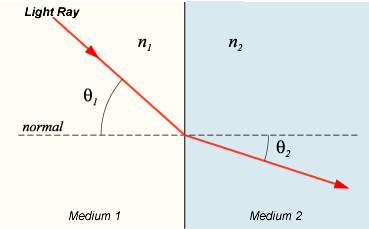Light Box
SED 695B; Fall 2005
Principles illustrated:
- Reflection
- Refraction
- Snell's Law

Standards addressed:
Grade 7 Life Science:
6c: Students know light travels in straight lines if the medium
it travels through does not change.
6d: Students know how simple lenses are used in a magnifying
glass, the eye, a camera, a telescope, and a microscope.
6f: Students know light can be reflected, refracted, transmitted,
and absorbed by matter.
6g: Students know the angle of reflection of a light beam is
equal to the angle of incidence.
Physics:
4f: Students know how to identify the characteristic properties of waves: interference (beats), diffraction, refraction, Doppler effect, and polarization.
Included in Kit (see below for picture)
- Light box
- Bulb
- Light cover to get single or multiple lines of light.
- Acrylic Blocks of various shapes
- Colored Cardboard
- Colored Acetate
- Mirrors of various shapes
Needed Separately
- Power source (12A 3V)
- Protractor
Reflection on a plane mirror states that the angle of incidence is equal to the angle of reflection, as measured from the normal.

Refraction is the bending of light as it travels through materials of different densities or indices of refraction. The amount of bending can be described using Snell's Law.

Snell's law describes the relationship between the angles of incidence and refraction for a wave moving from one media to another with differing indices of refraction. The law is given by the formula:
![]()
Where ![]() is the angle of incidence
(measured from the normal) and
is the angle of incidence
(measured from the normal) and ![]() is the angle of refraction (again measured from the normal) and
is the angle of refraction (again measured from the normal) and ![]() and
and
![]() are the indices of refraction
for the initial and final media, respectively.
are the indices of refraction
for the initial and final media, respectively.
Procedures:
Refraction with an extension to verify Snell's Law:
|
Angle of Reflection vs Angle of Incidence
|

References & Links:
A java demonstration of Refraction: http://www.falstad.com/ripple/ex-refraction.html
Another good applet: http://micro.magnet.fsu.edu/primer/java/scienceopticsu/refraction/refractionangles/index.html
Some useful pictures to aid in determining the angles of refraction: http://midwoodscience.org/elert/lab/refraction.pdf